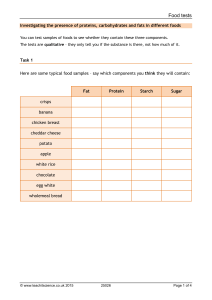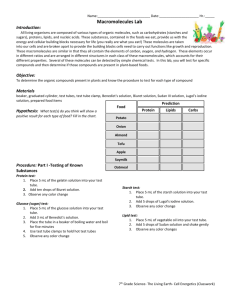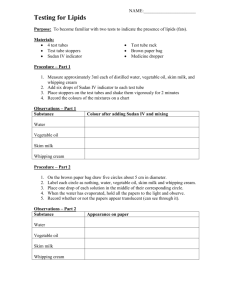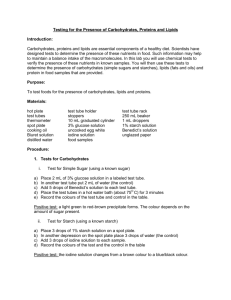Biomolecules Lab: Carbohydrates, Proteins, Lipids
advertisement
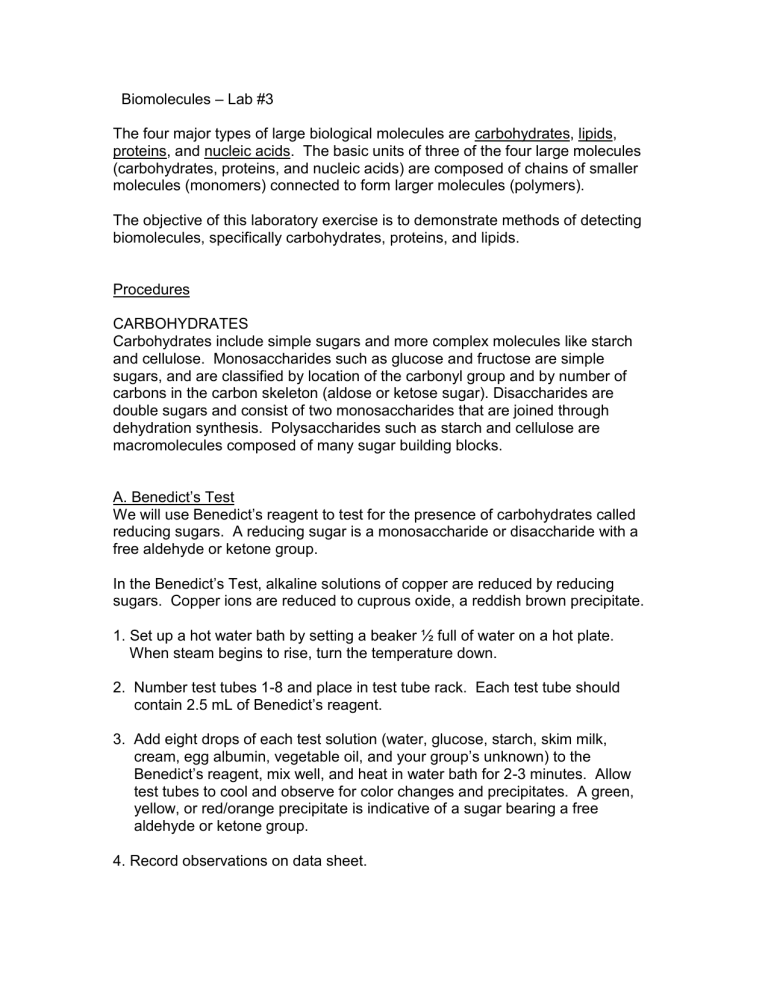
Biomolecules – Lab #3 The four major types of large biological molecules are carbohydrates, lipids, proteins, and nucleic acids. The basic units of three of the four large molecules (carbohydrates, proteins, and nucleic acids) are composed of chains of smaller molecules (monomers) connected to form larger molecules (polymers). The objective of this laboratory exercise is to demonstrate methods of detecting biomolecules, specifically carbohydrates, proteins, and lipids. Procedures CARBOHYDRATES Carbohydrates include simple sugars and more complex molecules like starch and cellulose. Monosaccharides such as glucose and fructose are simple sugars, and are classified by location of the carbonyl group and by number of carbons in the carbon skeleton (aldose or ketose sugar). Disaccharides are double sugars and consist of two monosaccharides that are joined through dehydration synthesis. Polysaccharides such as starch and cellulose are macromolecules composed of many sugar building blocks. A. Benedict’s Test We will use Benedict’s reagent to test for the presence of carbohydrates called reducing sugars. A reducing sugar is a monosaccharide or disaccharide with a free aldehyde or ketone group. In the Benedict’s Test, alkaline solutions of copper are reduced by reducing sugars. Copper ions are reduced to cuprous oxide, a reddish brown precipitate. 1. Set up a hot water bath by setting a beaker ½ full of water on a hot plate. When steam begins to rise, turn the temperature down. 2. Number test tubes 1-8 and place in test tube rack. Each test tube should contain 2.5 mL of Benedict’s reagent. 3. Add eight drops of each test solution (water, glucose, starch, skim milk, cream, egg albumin, vegetable oil, and your group’s unknown) to the Benedict’s reagent, mix well, and heat in water bath for 2-3 minutes. Allow test tubes to cool and observe for color changes and precipitates. A green, yellow, or red/orange precipitate is indicative of a sugar bearing a free aldehyde or ketone group. 4. Record observations on data sheet. B. Potassium iodide (I2KI) Test for Starch Potassium iodide (I2KI) or Lugol’s solution will produce a color change from light amber to blue-black in the presence of starch. 1. Number test tubes 1-8 and place in test tube rack. 2. Add 5 mL of test solution (water, glucose, starch, skim milk, cream, egg albumin, vegetable oil, and your group’s unknown) to the correctly labeled test tube. 3. Add 1-2 drops of Lugol’s solution to each test tube. 3. Record observations on data sheet. PROTEINS Proteins are polymers made up of amino acids linked together by peptide bonds. There are 20 different naturally occurring amino acids, common to all living systems. Proteins can be detected by a reaction with certain reagents to form various colored complexes. We will use the Biuret Test to detect the presence of protein in test solutions. In the Biuret Test, the change in color from blue to violet indicates the presence of protein. Biuret Test 1. Number test tubes 1-8 and place in test tube rack. 2. Add 2 mL of test solution (water, glucose, starch, skim milk, cream, egg albumin, vegetable oil, and your group’s unknown) to the correctly labeled test tube. 3. Add 4-6 drops of Biuret solution to all test tubes and mix well. 4. Record the results on data sheet. LIPIDS Lipids are very important to living organisms because they serve as a concentrated source of stored energy. The largest class of lipids, the triglycerides, are composed of fatty acids and a molecule of glycerol. Oils are triglycerides that are liquid at room temperature, whereas fats are solid at room temperature. We will use the Sudan IV stain to test for the presence of lipids. Sudan IV stain is a lipid specific stain that only mixes with oils. In a positive test, the Sudan IV stains the lipid a deep red color. Sudan IV Stain Test for Lipids 1. Number test tubes 1-8 and place in test tube rack. 2. Add 4 mL of water to each tube. 3. Add 2 mL of test solution (water, glucose, starch, skim milk, cream, egg albumin, vegetable oil, and your group’s unknown) to the correctly labeled test tube. 4. Add 8 drops of Sudan IV stain (liquid form) and shake the tubes vigorously. 5. Observe for 5 minutes and record results on data sheet. Data Sheet for Biomolecules Lab CARBOHYDRATES A. Benedict’s Test for reducing sugars Tube 1 2 3 4 5 6 7 8 Test Solution water glucose starch skim milk cream egg albumin vegetable oil unknown # __ Observations (use + or – and describe color) _______________________________________ _______________________________________ _______________________________________ _______________________________________ _______________________________________ _______________________________________ _______________________________________ _______________________________________ B. Potassium iodide (I2KI) Test for Starch Tube Test Solution Observations (use + or – and describe color) 1 water _______________________________________ 2 glucose _______________________________________ 3 starch _______________________________________ 4 skim milk _______________________________________ 5 cream _______________________________________ 6 egg albumin _______________________________________ 7 vegetable oil _______________________________________ 8 unknown # __ _______________________________________ PROTEINS Biuret Test Tube Test Solution 1 water 2 glucose 3 starch 4 skim milk 5 cream 6 egg albumin 7 vegetable oil 8 unknown # __ Observations (use + or – and describe color) _______________________________________ _______________________________________ _______________________________________ _______________________________________ _______________________________________ _______________________________________ _______________________________________ _______________________________________ LIPIDS Sudan IV Stain Test for Lipids Tube Test Solution Observations (use + or – and describe color) 1 water _______________________________________ 2 glucose _______________________________________ 3 starch _______________________________________ 4 skim milk _______________________________________ 5 cream _______________________________________ 6 egg albumin _______________________________________ 7 vegetable oil _______________________________________ 8 unknown # __ _______________________________________ My group’s unknown is _____________________.
